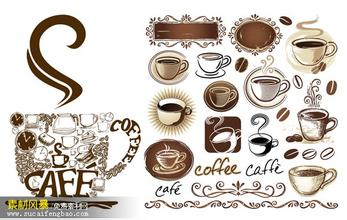Vietnamese coffee boutique coffee flavor taste manor production area introduces Vietnamese coffee brands
Coffee cultivation in Vietnam covers an area of about 500000 hectares, of which 10% are owned by state-owned enterprises and farms, and 85% by farmers and landowners. The scale of the manor is small, usually 2-5 hectares, and the large manor is about 30-50 hectares, but the number is small. Vietnamese coffee ranks second in all agricultural products exported from Vietnam, second only to rice. Every year, about 300000 farmers are engaged in coffee cultivation, with a labor force of 600000, and the labor force can reach 700000 to 800000 in the three-month harvest period. as a result, the coffee industry has absorbed 1.83% of the country's total labor force and 2.93% of the total agricultural labor force.
Vietnam Coffee Corporation (VINACAFE) is a 100% state-owned enterprise with 73 companies and farms under its jurisdiction. VINACAFE exports 20-25% of Vietnam's coffee production each year.
According to the business statistics of Vietnam Coffee Association, in 2000-2001 (from October 2000 to September 2001), a total of 874676 tons of coffee were exported from 149 units in Vietnam, of which the three largest export companies were OLAM (wholly foreign-owned enterprise, 21326 tons), DAKMAN (joint venture, 18076 tons) and VINAFIMEX (local enterprises, 13719 tons).
The Vietnam Coffee quality Standards Committee was led by the Vietnam Coffee Association to draft the Vietnam National Coffee Standard, which was reported to the Ministry of Science, Technology and Environment (now the Ministry of Science and Technology) for examination and approval. [3]
Processing and editing
Vietnam Coffee
Vietnam Coffee
In the field of coffee processing, there have been some dilapidated processing plants since 1975, and there are several processing plants in northern Tongjiao, Fukui and other places, whose equipment was made in East Germany from 1960 to 1962. In the south, the old factories left by former landowners such as ROSSI,DELPHANTE are also small. While expanding the coffee planting area, Yue also began to build new coffee processing plants, first producing some stand-alone equipment, and later imitating the production line according to the HANGXA style, the main manufacturers are the Haiphong May 1 Machinery Factory, the Ministry of Industry A74 Plant in Shoude, Ho Chi Minh City, and so on. In recent years, many companies and farms in Vietnam have imported new processing plants with relatively complete equipment from Germany and Brazil, and imported more than a dozen sets of coffee processing production lines from PINHALENSE of Brazil. Since then, more and more factories began to imitate and improve their own production of Brazilian equipment. In recent years, the processing capacity of Vietnamese coffee has been greatly improved, which can guarantee the export of 150000 to 200000 tons of coffee kernels per year. In addition, there are many enterprises with inadequate equipment, which only rely on a few stand-alone machines for processing, and purchase newly processed coffee from farmers to ensure export standards. The coffee purchased from the private sector is mainly handled by each farmer through the cement yard or soil yard. Farmers in many places use small grinders to grind dried coffee fruits into coffee kernels and sell them to coffee buyers. This kind of processing leads to the instability of product quality. Coffee produced by companies and farms is usually of good quality and beautiful appearance, such as thang loi, phuoc an, viet duc, buon ho, Deloitte, etc., which are recognized by customers. Generally speaking, the sale and sale of coffee has not been carried out in accordance with national standards for a long time, and the quality provisions in the sale and purchase contract are very simple, which are only determined through consultation between the buyer and the seller, which fails to effectively promote the improvement of coffee quality and the level of the processing industry.

Important Notice :
前街咖啡 FrontStreet Coffee has moved to new addredd:
FrontStreet Coffee Address: 315,Donghua East Road,GuangZhou
Tel:020 38364473
- Prev

Introduction of Yunnan Coffee Flavor Manor with balanced Taste
Coffee is a kind of beverage crop with high economic value, which is called the three largest beverages in the world together with cocoa and tea, and its output and consumption ranks first among the three beverages. Coffee is rich in protein, fat, sucrose, starch, glucose, caffeine and other substances, rich aroma and delicious taste. Coffee is a perennial evergreen shrub or small tree of the genus Coffea of Rubiaceae.
- Next

Introduction of Bali Coffee Flavor and Flavor Coffee beans in Manor production area
Another special sight is that most of the motorcycles in Bali only have a rearview mirror on one side, and the other side is not stolen, but dismantled by themselves. Because people here can't turn their minds around, they can only take care of one side of the car. Haha, what a classic! Therefore, when crossing the road here, we must pay attention to safety, because the probability of traffic accidents is still relatively high. after all
Related
- Detailed explanation of Jadeite planting Land in Panamanian Jadeite Manor introduction to the grading system of Jadeite competitive bidding, Red bid, Green bid and Rose Summer
- Story of Coffee planting in Brenka region of Costa Rica Stonehenge Manor anaerobic heavy honey treatment of flavor mouth
- What's on the barrel of Blue Mountain Coffee beans?
- Can American coffee also pull flowers? How to use hot American style to pull out a good-looking pattern?
- Can you make a cold extract with coffee beans? What is the right proportion for cold-extracted coffee formula?
- Indonesian PWN Gold Mandrine Coffee Origin Features Flavor How to Chong? Mandolin coffee is American.
- A brief introduction to the flavor characteristics of Brazilian yellow bourbon coffee beans
- What is the effect of different water quality on the flavor of cold-extracted coffee? What kind of water is best for brewing coffee?
- Why do you think of Rose Summer whenever you mention Panamanian coffee?
- Introduction to the characteristics of authentic blue mountain coffee bean producing areas? What is the CIB Coffee Authority in Jamaica?

